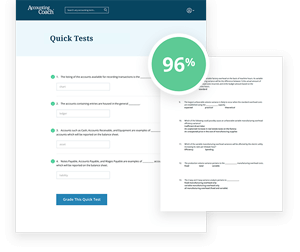1.
To start a corporation in the U.S., it is necessary to file an application in one of the states. The legal document that the state approves is the __________
articles of incorporation.
2.
One of the advantages of the corporation form of business as opposed to a partnership form is the ease of transferring __________
ownership.
3.
At a corporation, Assets minus Liabilities is __________
Stockholders' Equity.
4.
Shares of stock that have been issued and have not been reacquired by the issuing corporation are called __________
outstanding shares.
5.
If a corporation has issued only one type of stock, it is __________
common stock.
6.
The type of stock that gets its dividend before the common stock gets its dividend is called __________
preferred stock.
7.
The holders of __________
common stock elect the corporation's board of directors.
8.
The par value of __________
common stock usually has no economic significance.
9.
The dividend on preferred stock is often expressed as a percentage. To calculate the annual dividend on preferred stock, you multiply the percentage times the __________
par value of the preferred stock.
10.
If a corporation issues 10% Preferred Stock $100 Par on a day when the financial markets demand 9%, this corporation's 10% Preferred Stock will sell for __________
more than its par value.
11.
If a common stock does not have a par value or a stated value, the entire proceeds from issuing the stock is credited to one account entitled __________
Common Stock.
12.
Stockholder's equity is subdivided into two major sections:
__________
paid-in capital
and
__________
retained earnings
.
13.
The net income of a corporation is closed to the __________
Retained Earnings account.
14.
Dividends declared by a corporation reduce the __________
retained earnings section of stockholders' equity.
15.
Dividends appear as an expense on the corporation's income statement.
16.
If the board of directors does not declare the regular quarterly divided on its common stock, the corporation's liabilities will include the omitted dividend.
17.
The __________
declaration date is the date on which the corporation records a liability for its quarterly dividend.
18.
The __________
record date determines which stockholders will receive a declared dividend.
19.
If a corporation declares a small stock dividend, the account that will be reduced by a debit entry is __________
Retained Earnings.
20.
A stockholder will have the same number of shares after a 3-for-2 stock split or after a __________
50%% stock dividend.
21.
A corporation's own shares of stock that have been reacquired from its stockholders but have not been retired are called __________
treasury stock.
22.
The account, Treasury Stock, will have either a zero balance or a __________
debit (debit, credit) balance.
23.
If a share of treasury stock is sold for more than its cost, the difference is credited to __________
Paid-in Capital from Treasury Stock.
24.
Treasury stock sales can result in a loss on the corporation's income statement.
25.
If preferred stockholders have the opportunity to receive more than the stated dividend percentage, the stock is described as __________
participating preferred stock.
26.
Dividends in arrears occur only on __________
cumulative preferred stock.
27.
Dividends in arrears are reported in the financial statements in the __________
notes or footnotes.
28.
If a preferred stock can be exchanged for a stated number of common shares, it is referred to as __________
convertible preferred stock.
29.
The book value per share of preferred stock is its
plus any dividends in
.
30.
Earnings per share means earnings per share of __________
common stock.
31.
A debit balance in Retained Earnings will be described in the stockholders' equity section of the balance sheet as __________
deficit or accumulated deficit.
32.
The __________
board of directors of a corporation declares the dividends.
33.
The directors of a corporation appoint __________
officers to carry out the corporation's policies and directives.
34.
When a small stock dividend is declared, the __________
market value of the new shares is transferred from Retained Earnings to paid-in capital accounts.
35.
A separate portion of stockholders' equity that reports certain gains and losses on hedges, foreign currency translations, and pension liabilities that were not part of net income shown on the income statement is __________
accumulated other comprehensive income.


